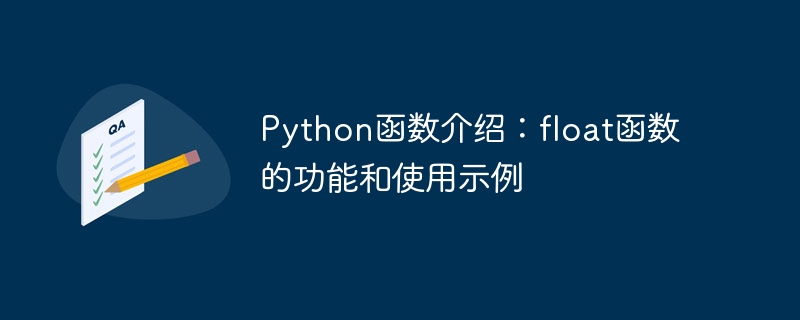

Introduction to Python functions: functions and usage examples of float functions
Python is a high-level programming language widely used in many fields. It provides a wealth of built-in functions so that developers can develop and process data more conveniently. One of them is the float function, which is used to convert strings or numbers into floating point types. In this article, we will introduce the functions of the float function in detail and give some usage examples.
Function introduction of float function:
The float function is used in Python to convert strings, integers or floating-point numbers into floating-point types. Its syntax format is as follows:
float(x)
The parameter x can be a string representing a number, an integer or a floating point number, and the return value is the converted floating point number. If x cannot be converted to a floating-point number type, the float function will throw a ValueError exception.
Usage example 1: Convert string to floating point number
num_str = "3.14" num_float = float(num_str) print(num_float)
Output:
3.14
In the above example, we convert the string "3.14" as a floating point number and print it out. As you can see, the float function successfully converts the string into the corresponding floating point number.
Usage example 2: Convert integer to floating point number
num_int = 12345 num_float = float(num_int) print(num_float)
Output:
12345.0
In this example, we convert the integer 12345 to a floating point number and print it . The result can be seen as a floating point number 12345.0.
Usage example 3: Convert floating point number to floating point number
num_float = 3.14159 num_float = float(num_float) print(num_float)
Output:
3.14159
In this example, we convert the floating point number 3.14159 to a floating point number and print it out. The result is still 3.14159.
Usage Example 4: Handling Unconvertible Cases
num_str = "Hello"
try:
num_float = float(num_str)
print(num_float)
except ValueError:
print("无法转换为浮点数")Output:
Cannot be converted to a floating point number
In this example, we are trying to convert a non-convertible to Convert the floating point number to the string "Hello". Since it cannot be converted, the float function throws a ValueError exception. We catch this exception in the except block and print an error message.
Summary:
The float function is very commonly used in Python. It can convert strings, integers or floating point numbers into floating point number types. The float function can conveniently handle the conversion needs of various numerical types, but it should be noted that if the provided parameters cannot be converted to floating point numbers, the float function will throw a ValueError exception. In actual development, we can use the float function to perform reasonable data conversion according to specific needs.
The above is the detailed content of Introduction to Python functions: functions and usage examples of float functions. For more information, please follow other related articles on the PHP Chinese website!




